Strategies of Alexander in the Battles of Issus and Gaugamela
VerifiedAdded on 2023/04/23
|6
|1084
|378
AI Summary
This document discusses the strategies used by Alexander in the battles of Issus and Gaugamela. It covers the battle plans, tactics, and strengths of Alexander's army. The document also includes references for further reading.
Contribute Materials
Your contribution can guide someone’s learning journey. Share your
documents today.
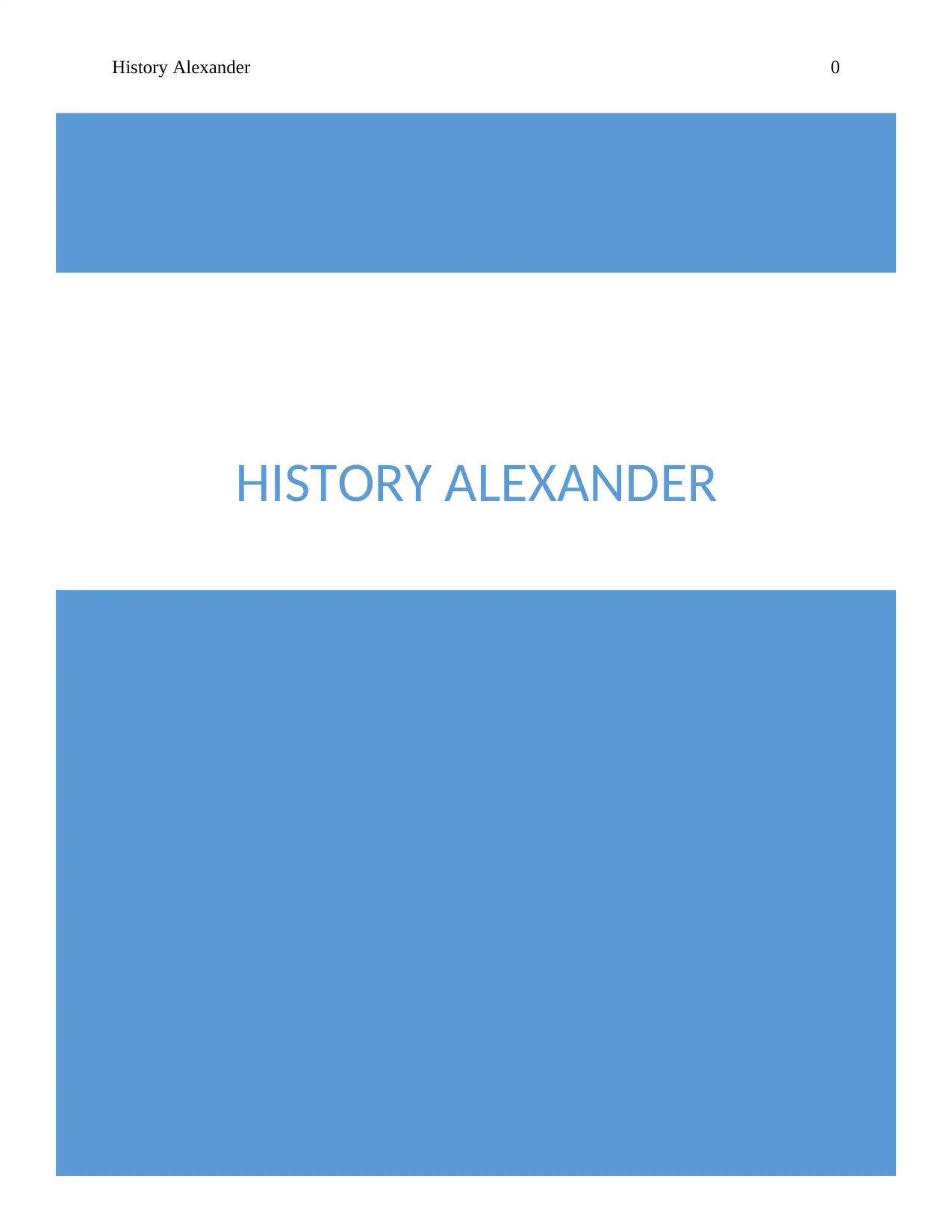
HISTORY ALEXANDER
History Alexander 0
History Alexander 0
Secure Best Marks with AI Grader
Need help grading? Try our AI Grader for instant feedback on your assignments.
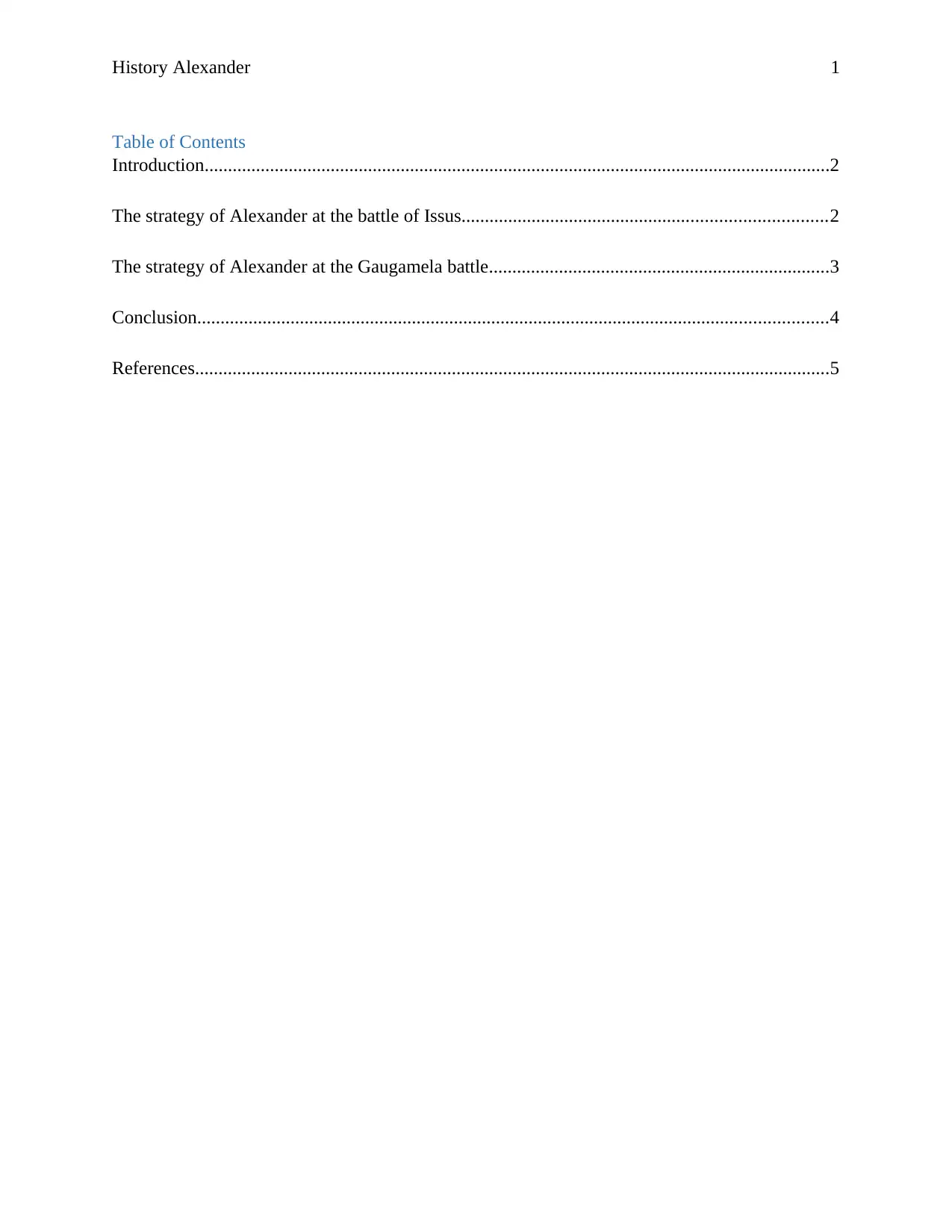
History Alexander 1
Table of Contents
Introduction......................................................................................................................................2
The strategy of Alexander at the battle of Issus..............................................................................2
The strategy of Alexander at the Gaugamela battle.........................................................................3
Conclusion.......................................................................................................................................4
References........................................................................................................................................5
Table of Contents
Introduction......................................................................................................................................2
The strategy of Alexander at the battle of Issus..............................................................................2
The strategy of Alexander at the Gaugamela battle.........................................................................3
Conclusion.......................................................................................................................................4
References........................................................................................................................................5

History Alexander 2
Introduction
Alexander was a king of the ancient Greek kingdom of Macedon. He was the greatest
military leader (Worthington, By the Spear: Philip II, Alexander the Great, and the Rise and Fall
of the Macedonian Empire, 2014). He dealt with his enemies at home. He reasserted the power
of Macedonian within Greece. The biggest strength of the Alexander army was mobility
(Worthington, Alexander the Great, 2012). Alexander used the strategies in the battle of Issus
and Gaugamela, which have been covered in the following discussion.
The strategy of Alexander at the battle of Issus
Battle of Issus, (333 BC), conflict early in Alexander the Great's invasion of Asia in this
battle. Alexander conquered the empire of Achaemenian. The objective of the war was revenge.
Alexander always stood at the front of the battle. The strategy of Alexander in this war was that
the unit of Alexander was positioned in a wedge position as Alexander believes this made their
soldiers impossible for the opposing army to punch a hole and harder to crack (Brosius, 2003).
He moved to Issus with his army and then along the cost road. He predicted to meet the
challengers at same point. The battlefield, on the plains of Issus, was bordered on the one side by
a range of mountain and by the Mediterranean on the other. At the right flank of Alexander
quickly overtook left plank of Persian. The Greek mercenaries took the Macedonian’s left flank.
The right flank moved to the center causing Darius to retreat and the Persian army to lose.
Alexander copied the phalanx from the Greeks. In the battle, there was 16 men wide and 16 men
deep (Murrison, 2012).
Introduction
Alexander was a king of the ancient Greek kingdom of Macedon. He was the greatest
military leader (Worthington, By the Spear: Philip II, Alexander the Great, and the Rise and Fall
of the Macedonian Empire, 2014). He dealt with his enemies at home. He reasserted the power
of Macedonian within Greece. The biggest strength of the Alexander army was mobility
(Worthington, Alexander the Great, 2012). Alexander used the strategies in the battle of Issus
and Gaugamela, which have been covered in the following discussion.
The strategy of Alexander at the battle of Issus
Battle of Issus, (333 BC), conflict early in Alexander the Great's invasion of Asia in this
battle. Alexander conquered the empire of Achaemenian. The objective of the war was revenge.
Alexander always stood at the front of the battle. The strategy of Alexander in this war was that
the unit of Alexander was positioned in a wedge position as Alexander believes this made their
soldiers impossible for the opposing army to punch a hole and harder to crack (Brosius, 2003).
He moved to Issus with his army and then along the cost road. He predicted to meet the
challengers at same point. The battlefield, on the plains of Issus, was bordered on the one side by
a range of mountain and by the Mediterranean on the other. At the right flank of Alexander
quickly overtook left plank of Persian. The Greek mercenaries took the Macedonian’s left flank.
The right flank moved to the center causing Darius to retreat and the Persian army to lose.
Alexander copied the phalanx from the Greeks. In the battle, there was 16 men wide and 16 men
deep (Murrison, 2012).
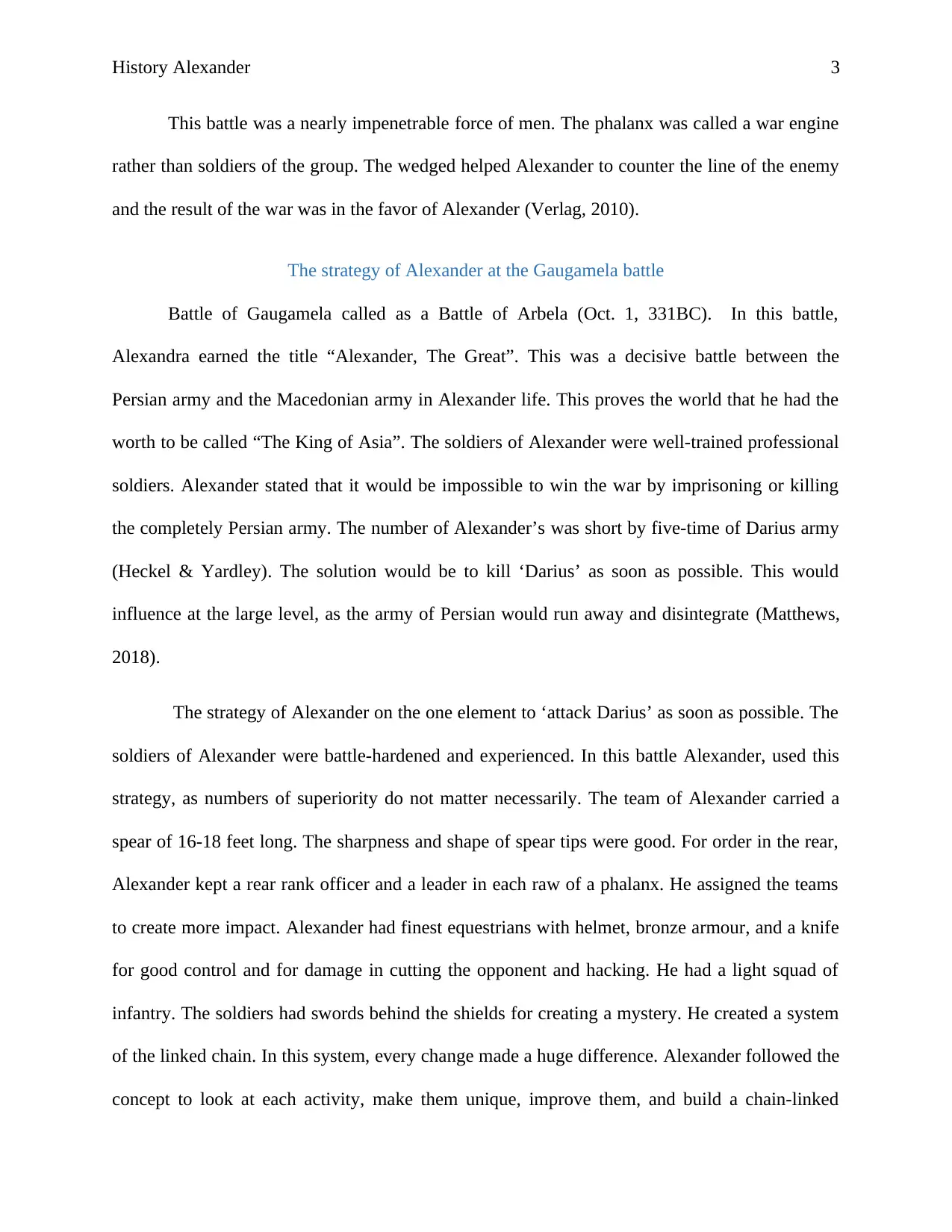
History Alexander 3
This battle was a nearly impenetrable force of men. The phalanx was called a war engine
rather than soldiers of the group. The wedged helped Alexander to counter the line of the enemy
and the result of the war was in the favor of Alexander (Verlag, 2010).
The strategy of Alexander at the Gaugamela battle
Battle of Gaugamela called as a Battle of Arbela (Oct. 1, 331BC). In this battle,
Alexandra earned the title “Alexander, The Great”. This was a decisive battle between the
Persian army and the Macedonian army in Alexander life. This proves the world that he had the
worth to be called “The King of Asia”. The soldiers of Alexander were well-trained professional
soldiers. Alexander stated that it would be impossible to win the war by imprisoning or killing
the completely Persian army. The number of Alexander’s was short by five-time of Darius army
(Heckel & Yardley). The solution would be to kill ‘Darius’ as soon as possible. This would
influence at the large level, as the army of Persian would run away and disintegrate (Matthews,
2018).
The strategy of Alexander on the one element to ‘attack Darius’ as soon as possible. The
soldiers of Alexander were battle-hardened and experienced. In this battle Alexander, used this
strategy, as numbers of superiority do not matter necessarily. The team of Alexander carried a
spear of 16-18 feet long. The sharpness and shape of spear tips were good. For order in the rear,
Alexander kept a rear rank officer and a leader in each raw of a phalanx. He assigned the teams
to create more impact. Alexander had finest equestrians with helmet, bronze armour, and a knife
for good control and for damage in cutting the opponent and hacking. He had a light squad of
infantry. The soldiers had swords behind the shields for creating a mystery. He created a system
of the linked chain. In this system, every change made a huge difference. Alexander followed the
concept to look at each activity, make them unique, improve them, and build a chain-linked
This battle was a nearly impenetrable force of men. The phalanx was called a war engine
rather than soldiers of the group. The wedged helped Alexander to counter the line of the enemy
and the result of the war was in the favor of Alexander (Verlag, 2010).
The strategy of Alexander at the Gaugamela battle
Battle of Gaugamela called as a Battle of Arbela (Oct. 1, 331BC). In this battle,
Alexandra earned the title “Alexander, The Great”. This was a decisive battle between the
Persian army and the Macedonian army in Alexander life. This proves the world that he had the
worth to be called “The King of Asia”. The soldiers of Alexander were well-trained professional
soldiers. Alexander stated that it would be impossible to win the war by imprisoning or killing
the completely Persian army. The number of Alexander’s was short by five-time of Darius army
(Heckel & Yardley). The solution would be to kill ‘Darius’ as soon as possible. This would
influence at the large level, as the army of Persian would run away and disintegrate (Matthews,
2018).
The strategy of Alexander on the one element to ‘attack Darius’ as soon as possible. The
soldiers of Alexander were battle-hardened and experienced. In this battle Alexander, used this
strategy, as numbers of superiority do not matter necessarily. The team of Alexander carried a
spear of 16-18 feet long. The sharpness and shape of spear tips were good. For order in the rear,
Alexander kept a rear rank officer and a leader in each raw of a phalanx. He assigned the teams
to create more impact. Alexander had finest equestrians with helmet, bronze armour, and a knife
for good control and for damage in cutting the opponent and hacking. He had a light squad of
infantry. The soldiers had swords behind the shields for creating a mystery. He created a system
of the linked chain. In this system, every change made a huge difference. Alexander followed the
concept to look at each activity, make them unique, improve them, and build a chain-linked
Secure Best Marks with AI Grader
Need help grading? Try our AI Grader for instant feedback on your assignments.
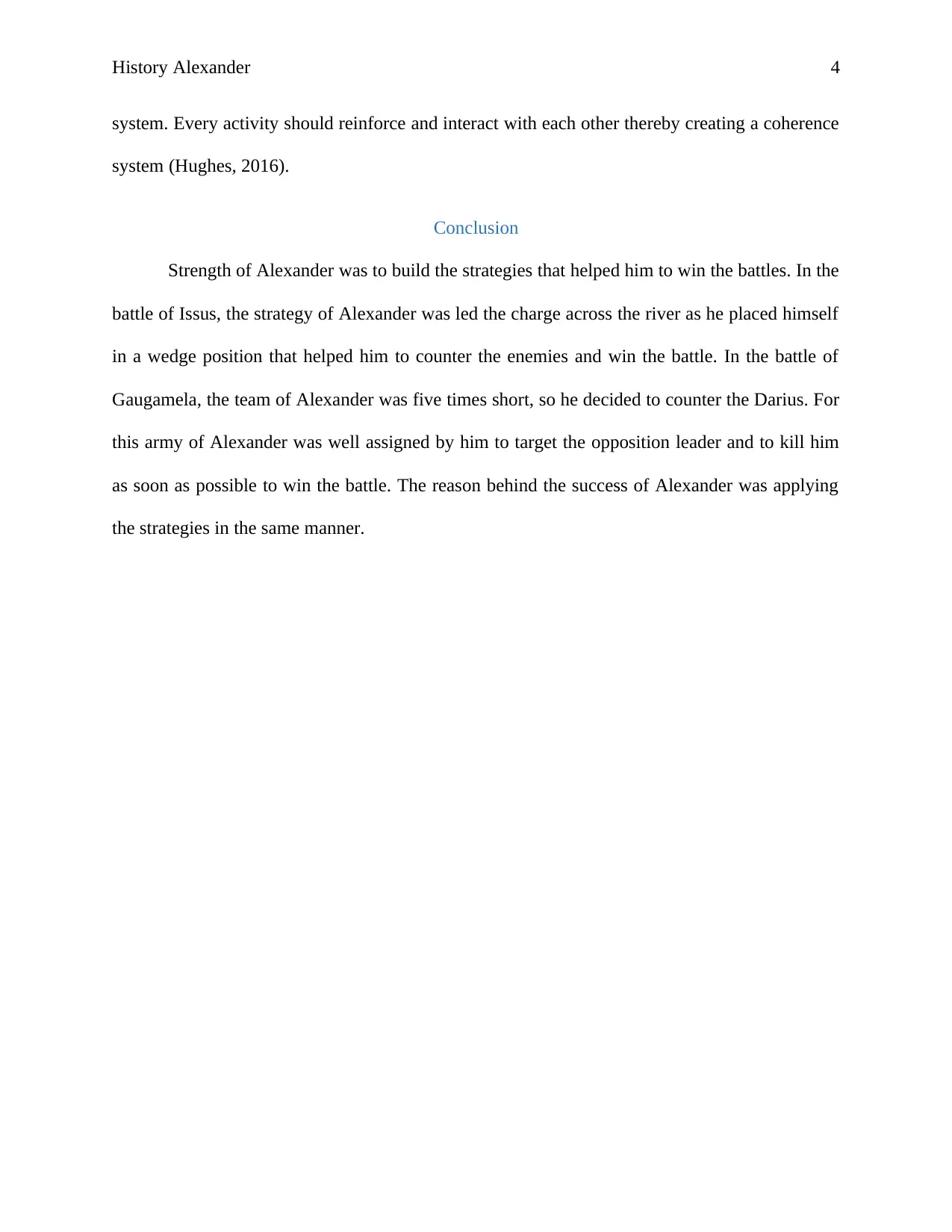
History Alexander 4
system. Every activity should reinforce and interact with each other thereby creating a coherence
system (Hughes, 2016).
Conclusion
Strength of Alexander was to build the strategies that helped him to win the battles. In the
battle of Issus, the strategy of Alexander was led the charge across the river as he placed himself
in a wedge position that helped him to counter the enemies and win the battle. In the battle of
Gaugamela, the team of Alexander was five times short, so he decided to counter the Darius. For
this army of Alexander was well assigned by him to target the opposition leader and to kill him
as soon as possible to win the battle. The reason behind the success of Alexander was applying
the strategies in the same manner.
system. Every activity should reinforce and interact with each other thereby creating a coherence
system (Hughes, 2016).
Conclusion
Strength of Alexander was to build the strategies that helped him to win the battles. In the
battle of Issus, the strategy of Alexander was led the charge across the river as he placed himself
in a wedge position that helped him to counter the enemies and win the battle. In the battle of
Gaugamela, the team of Alexander was five times short, so he decided to counter the Darius. For
this army of Alexander was well assigned by him to target the opposition leader and to kill him
as soon as possible to win the battle. The reason behind the success of Alexander was applying
the strategies in the same manner.
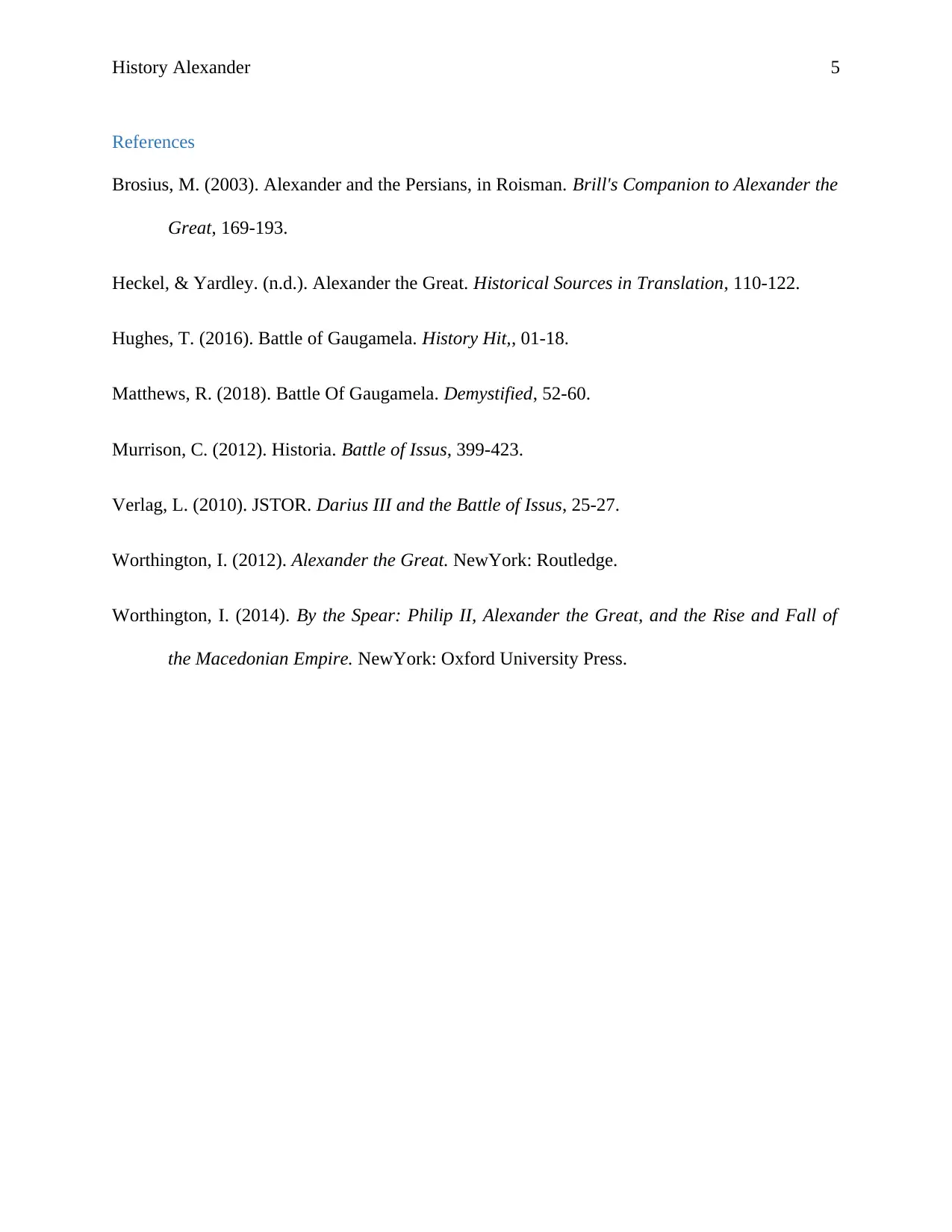
History Alexander 5
References
Brosius, M. (2003). Alexander and the Persians, in Roisman. Brill's Companion to Alexander the
Great, 169-193.
Heckel, & Yardley. (n.d.). Alexander the Great. Historical Sources in Translation, 110-122.
Hughes, T. (2016). Battle of Gaugamela. History Hit,, 01-18.
Matthews, R. (2018). Battle Of Gaugamela. Demystified, 52-60.
Murrison, C. (2012). Historia. Battle of Issus, 399-423.
Verlag, L. (2010). JSTOR. Darius III and the Battle of Issus, 25-27.
Worthington, I. (2012). Alexander the Great. NewYork: Routledge.
Worthington, I. (2014). By the Spear: Philip II, Alexander the Great, and the Rise and Fall of
the Macedonian Empire. NewYork: Oxford University Press.
References
Brosius, M. (2003). Alexander and the Persians, in Roisman. Brill's Companion to Alexander the
Great, 169-193.
Heckel, & Yardley. (n.d.). Alexander the Great. Historical Sources in Translation, 110-122.
Hughes, T. (2016). Battle of Gaugamela. History Hit,, 01-18.
Matthews, R. (2018). Battle Of Gaugamela. Demystified, 52-60.
Murrison, C. (2012). Historia. Battle of Issus, 399-423.
Verlag, L. (2010). JSTOR. Darius III and the Battle of Issus, 25-27.
Worthington, I. (2012). Alexander the Great. NewYork: Routledge.
Worthington, I. (2014). By the Spear: Philip II, Alexander the Great, and the Rise and Fall of
the Macedonian Empire. NewYork: Oxford University Press.
1 out of 6
Related Documents
Your All-in-One AI-Powered Toolkit for Academic Success.
+13062052269
info@desklib.com
Available 24*7 on WhatsApp / Email
![[object Object]](/_next/static/media/star-bottom.7253800d.svg)
Unlock your academic potential
© 2024 | Zucol Services PVT LTD | All rights reserved.





